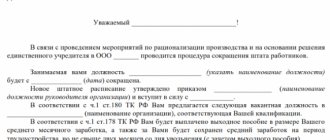When the initiative for dismissal does not come from the employee, any reason will be unpleasant to him. However, among all other situations where an employee leaves the service at the suggestion of his superiors, dismissal due to redundancy is one of the most “benign”, since it does not involve the employee’s fault. But this type of reduction is the most costly for the employer.
In this article we will try to cover all the points that an employer needs to know in order to properly carry out a reduction. The fact is that employees are legally protected much more strongly, and the employer has many obligations that must be observed in order to avoid conflicts or even litigation. To do this, you must strictly follow the protocol prescribed in the Commercial Code of the Russian Federation.
When staffing is downsized
In business, various unforeseen situations often occur. If they are associated with additional difficulties, including financial ones, it is necessary to cut costs, reduce costs, and reduce the number of personnel. To do this, employers choose one of two ways or combine them:
- trying to make do with fewer employees – reducing the number of staff;
- removing certain positions or staffing units for them - staff reduction.
REFERENCE! If positions that are currently vacant are removed from the staffing table, this does not constitute a reduction.
Article 81 of the Labor Code of the Russian Federation regulates in detail all the provisions for the dismissal of an employee from a position as a result of reduction.
What vacancies can be offered?
Labor legislation outlines the criteria that positions offered to employees must meet. These include:
- the place of work must be free;
- there is a correspondence between the qualifications of a citizen or an offer of a lower position is acceptable;
- the citizen must be suitable for the proposed job due to health reasons;
- It is necessary to find a job in the same area. The exception is when, in accordance with a labor or collective agreement, the company has the opportunity to offer labor elsewhere.
The Labor Code of the Russian Federation does not provide details on this topic; for this reason, the company’s management in this area uses the practice of judicial authorities and rules related to business turnover.
You can also point out that the legislation does not reflect the concept of a vacant position. For this reason, practice refers to a place of work that is reflected in the staffing table and, at the same time, not occupied by another citizen. In this case, it is not clear whether the position will be vacant when it is filled by a temporarily absent person. For example, this is a citizen who provides child care or a woman who is pregnant.
In this situation, in fact, the position is temporarily vacant, since the citizen is absent from work, but since this position is reserved for him, it cannot be completely vacant. In this regard, the law does not stipulate that the company’s management cannot offer such positions for replacement. The main condition is that there are no other empty seats.
The legislator indicates that only those vacancies that meet his qualifications can be offered to a citizen. Also, the job may be lower-level and lower-paid. The Labor Code of the Russian Federation reflects the concept of qualification. It is considered as an indicator indicating a person’s knowledge, skills and abilities. You can determine whether the qualifications and the position match using the job description.
The management of the organization has a responsibility related to the fact that it must offer a person all vacancies, including those that require a lower salary. If this rule is not taken into account by the management team of the company, as a result, the downsizing process may be considered untrue.
Then sanctions are applied to the employer.
Determining the working optimum
Before starting to select candidates for dismissal, the employer must answer the question of how many employees he intends to keep and in what positions. In other words, the staffing table should be revised. The employer makes a decision and, based on it, makes changes to the previously existing staffing table.
FOR YOUR INFORMATION! In the new schedule, the reduction should actually be real. It is unacceptable, along with the reduction in the number of employees or the abolition of some positions, to introduce others in their place, to which other people will need to be appointed.
The head of the company, having drawn up a new staffing table, issues an order for its approval. This is not yet an order for staff reductions and layoffs, but a mandatory preliminary procedure. It does not matter much in what form this order will be drawn up; it is important that it contains the date from which the new staffing table will be considered valid. The employer will build on this date when planning the next stages of reduction, in particular, notifying employees.
Job Notification Form
There is no set form for notifying an employee. A free-form form is developed by the enterprise using references to legal norms and following the procedure for composing a business letter.
| Notification information | Description |
| Information about the enterprise | At the top of the sheet the main details of the enterprise are indicated in accordance with the constituent documents |
| date | The date of the document is indicated |
| Basis for the vacancy offer | As a basis, it is necessary to enter the data of the reduction order |
| List of vacancies available on a specific date | Information about vacancies is presented in a short form with mandatory data on the proposed salary. |
| additional information | The document contains an offer to agree to fill a vacancy or to refuse a position. |
The document is signed by the director of the enterprise or another person temporarily replacing the director. After receiving the proposal, the employee must indicate the decision and make a signature and date entry.
What to consider when dismissing an employee
A manager, making a difficult decision about who will stay and who will be laid off, cannot be guided by his own desires or aversions. Retrenchment comes with a right of first refusal, meaning that some employees are less likely to be laid off than others. Let's consider the factors that influence the choice of a manager (Article 179 of the Labor Code of the Russian Federation).
- Employee qualifications . Persons with higher qualifications have priority.
- Labor productivity . Those who perform better or exceed established standards, have fewer or have not been subject to administrative penalties, awards or other incentives, should be less afraid of layoffs than employees with less rosy reputations.
- Other priorities. If points 1 and 2 are approximately equal for different employees, the manager will choose to remain at work:
- having 2 or more offspring or other dependents;
- the sole breadwinner of the family;
- combat disabled person;
- an employee who was previously injured at the enterprise;
- employee sent to improve their skills.
- Preferential categories . All other things being equal, the preferential right will be on the side of employees who were “Chernobyl survivors” (clause 7, clause 1, article 14 of the Law “On Social Protection” of May 15, 1991), persons affected by the tests in Semipalatinsk (clause 10, art. 2 Federal Law No. 2 of January 10, 2002), as well as Heroes of the USSR and Russia and full Order Bearers of Glory (clause 1 of Article 8 of Law No. 4301-1 of January 15, 1993)
A comparative analysis of all these points should be reflected in the personal files of each candidate for dismissal.
Who should not be laid off?
Some categories of employees cannot be dismissed on this basis. Clause 2 of Article 81 of the Labor Code of the Russian Federation cannot be applied to:
- those on sick leave (Part 6 of Article 81 of the Labor Code);
- women in an “interesting” position (Article 261 of the Labor Code);
- mothers of children under 3 years old;
- single mothers, if their children are under 14, and disabled children are 18 years old;
- persons in whose care there is a child without a mother;
- members of the trade union organization (clauses 2, 3, 5 of Article 81 of the Labor Code).
IMPORTANT! Workers from these categories who have been subject to unlawful layoffs are easily reinstated through the courts, causing the employer a lot of trouble.
Alarming news delivered on time
The “lucky ones” whom the employer has decided to sacrifice to reduce staff should find out about this in advance. Within 2 months, employees will have written notice of their upcoming “freedom.” Soon-to-be-former employees must sign for this notice.
NOTE! Only handing over a notice against signature does not contradict the procedure. Oral announcements, negotiations, placing information on a stand, etc. the methods have no legal force: if the legality of the layoff is challenged, the employer will not be able to prove that he warned the employee on time.
Deadlines for notification of vacancies
of the upcoming dismissal due to reduction at least two months before the proposed changes . Accordingly, if there are vacant positions at this moment, the employer offers them immediately. If they were not there, but they appeared later or other places became available, then it is necessary to notify the employee about this until the contract with him is terminated.
If the employee himself applied to the administration of the enterprise with an application to terminate the employment contract earlier than the period specified in the notice and was fired after some time, the employer, after the official termination of the contract, is not obliged to offer them to the employee.
When a staff reduction is carried out at an enterprise, the employee with whom the contract is to be terminated must be offered employment options in the organization. If vacancies appear later, then they also need to be reported. This is done in writing.
The employee, in turn, can agree and write an application for transfer or refuse. But he also does this in writing. After early dismissal at the employee’s request, the employer is not obliged to offer him the vacated positions.
Layoff or other job
Before laying off an employee, the employer is obliged to offer him other positions according to his qualifications, if they exist and are vacant. They must be offered right up to dismissal. The list of proposals should be indicated in the notice given 2 months in advance. If the employee agrees, a transfer will follow instead of a layoff. If there are no suitable positions or the employee’s consent, the dismissal will continue as usual.
The union is aware
The trade union (if it operates in the organization) must be notified of the upcoming layoff within the same 2 months as the employees. If you plan to dismiss more than 15 people, the period will increase to 3 months. With such large-scale reductions, the Employment Service must also be warned.
How many times should vacancies be offered?
All citizens who are subject to the reduction process receive offers for available vacancies. The company compiles a list in writing and submits it to individuals for review. At the same time, the act must indicate the responsibilities associated with occupying a particular position and the amount of earnings. Until the relationship with the citizen is terminated, the company must draw up 3 such acts.
For the first time, the paper is sent to the citizen at the time he receives notification of the upcoming layoff. Then, after a month, he is given a second notification. If the situation is such that the list has undergone changes, this should be reflected in the previously issued act. The third time the company announces vacancies is the day before layoffs occur.
The provisions of Article 180 of the Labor Code of the Russian Federation indicate that a person is not obliged to agree to the proposed places of work. This issue is resolved at his discretion. If a person refuses, this must be expressed in written format. When a citizen refuses the offer all 3 times, this indicates termination of the employment relationship, for which an order is issued. In this case, the individual employee’s own desire is used as the basis.
Compensating for job loss
This basis for dismissal provides the largest payments to exempt employees. Upon receiving an entry in the employment contract regarding the termination of an employment contract to reduce the organization's staff, clause 2, part 1, article 81 of the Labor Code of the Russian Federation, the employee has the right to:
- severance pay (another salary calculated as the average amount per month);
- after dismissal, the average salary will be accrued for another 2 months if during this time the person fails to find a new job;
- another average monthly salary (for the third month after dismissal) can be accrued if the dismissed employee joined the labor exchange within two weeks and has not yet been employed during these months;
- regular dismissal payments - accruals for sick leave (if any), compensation for unfilled vacation days;
- additional compensation - if the employee leaves before 2 months after the news of the layoff (the amount will be proportional to the payment for the remaining time of work).
The Supreme Court clarified the responsibilities of the employer during layoffs
Vitaly Aksenov* held various positions at the Mining and Chemical Combine, owned by the Rosatom state corporation, for almost 29 years (from 1990 to 2019), and since 2022 he has been a milling operator. In October 2018, he received notice of the upcoming layoff. He was fired on January 10, 2022. Aksenov considered that the employer’s actions were illegal, since he was not offered a different rate. Therefore, the plant employee went to court.
Decisions in favor of the employer
Aksenov stated in court that the enterprise had such available vacancies as a special train operator, an office inspector, a baker, a bus driver, and a storekeeper. The employer offered these positions to other laid-off employees, but did not give the plaintiff any alternative. The former employee considered that the plant had violated his rights and asked the court to reinstate him as a milling machine operator, to recover from the Mining and Chemical Plant the average salary for the period of forced absence (almost 230,000 rubles), and compensation for moral damages (100,000 rubles).
Company versus employee: problems with dismissal and more
A representative of the plant objected that there were no violations. They decided to transfer the tasks performed by milling operators to third-party specialized organizations. The general director believed that this would increase work efficiency. The plant offered all the rates available at that time to other employees, and they agreed. There was no free place for Aksenov, so he was not offered an option for his position. The employer decides which of the dismissed employees will offer a vacant position, since this procedure is not regulated by law, a representative of the enterprise indicated.
The first instance agreed with the defendant. The court indicated: according to Art. 81 of the Labor Code (“Termination of an employment contract at the initiative of the employer”), an employee can be laid off if he cannot be transferred to another position. Resolution of the Plenum of the Supreme Court dated March 17, 2004 No. 2 “On the application of the Labor Code by courts” allows dismissal due to reduction if a person did not have a preferential right to remain at work and was warned about dismissal two months in advance (part 2, paragraph 29). The Zheleznogorsk City Court of the Krasnoyarsk Territory indicated that Aksenov knew in advance about the termination of the employment contract, because the notice contained his signature. And there was no ban on dismissal, as well as other vacant positions. Therefore, the court rejected Aksenov’s claim (case No. 2-736/2019). The appeal and cassation turned out to be of the same opinion. Then the plaintiff complained to the Supreme Court.
Not a right, but a duty
The case was considered by a trio of judges chaired by Svetlana Frolkina. As the Supreme Court decided, Art. 180 of the Labor Code (“Guarantees and compensation to employees in the event of liquidation of an organization, reduction of the number or staff of an organization’s employees”) obliges, in the event of a reduction, to offer the employee another position. This is a guarantee against arbitrary dismissal of specialists. At the same time, the employer must find alternative rates for all dismissed specialists. And they will already decide whether to agree or not. The trio of judges decided: the lower authorities unlawfully agreed with the defendant’s arguments that the employer himself decides which of the dismissed employees will be offered open vacancies.
To offer an employee all available vacant positions during layoffs is not the employer’s right, but his responsibility, the Supreme Court noted.
According to the panel, the dispute should have established whether, from the moment of notification until the day of Aksenov’s dismissal, there were vacancies that would correspond to his qualifications, or lower positions with a lower salary. The Supreme Court also pointed out that the courts did not give a legal assessment to the order of the general director to reduce staff. Therefore, the conclusions of the lower authorities about the legality of the plaintiff’s dismissal are erroneous, the judges decided and sent the case to the first instance. The dispute has not yet been considered (case No. 53-KG20-4-K8).
“The definition of the Armed Forces forces us to reconsider the approach to staff reduction,” says Anna Ivanova, head of the labor law practice at Egorov, Puginsky, Afanasyev and Partners Federal Rating. group Antimonopoly law (including disputes) group Arbitration proceedings (major disputes - high market) group Compliance group Corporate law/Mergers and acquisitions (high market) group International arbitration group Maritime law group Tax consulting and disputes (Tax consulting) group Dispute resolution in courts general jurisdiction group Capital markets group Sanctions law group Family and inheritance law group Insurance law group TMT (telecommunications, media and technology) group Transport law group Labor and migration law (including disputes) group Criminal law group Pharmaceuticals and healthcare group Financial/Banking law group Private capital group Environmental law group Bankruptcy (including disputes) (high market) group Foreign trade activities/Customs law and currency regulation group PPP/Infrastructure projects group Land law/Commercial real estate/Construction group Intellectual property (Protection of rights and litigation) group Intellectual property ( Registration) group International litigation group Tax consulting and disputes (Tax disputes) group Natural resources/Energy group Digital economy group Intellectual property (Consulting) 1st place By revenue 1st place By revenue per lawyer (more than 30 lawyers) 1st place By number of lawyers Company profile. According to her, previously the courts took the opposite position. For example, the Volgograd Regional Court in case No. 33-8366/2020 or the Smolensk Regional Court in case No. 33-3851/2012.
The SC believes that all employees should receive notice of vacancies in the company. But what to do if there is only one position, but there are several employees being laid off? It would be worse for the employer to offer one position to everyone, get consent, and hire someone at their own discretion.
Anna Ivanova, head of labor law practice at AB Egorov, Puginsky, Afanasyev and partners Egorov, Puginsky, Afanasyev and partners Federal rating. group Antimonopoly law (including disputes) group Arbitration proceedings (major disputes - high market) group Compliance group Corporate law/Mergers and acquisitions (high market) group International arbitration group Maritime law group Tax consulting and disputes (Tax consulting) group Dispute resolution in courts general jurisdiction group Capital markets group Sanctions law group Family and inheritance law group Insurance law group TMT (telecommunications, media and technology) group Transport law group Labor and migration law (including disputes) group Criminal law group Pharmaceuticals and healthcare group Financial/Banking law group Private capital group Environmental law group Bankruptcy (including disputes) (high market) group Foreign trade activities/Customs law and currency regulation group PPP/Infrastructure projects group Land law/Commercial real estate/Construction group Intellectual property (Protection of rights and litigation) group Intellectual property ( Registration) group International litigation group Tax consulting and disputes (Tax disputes) group Natural resources/Energy group Digital economy group Intellectual property (Consulting) 1st place By revenue 1st place By revenue per lawyer (more than 30 lawyers) 1st place By number of lawyers Company profile
This is what happened with the employee who was reinstated this summer, Ivanova continues. The Sverdlovsk Regional Court motivated this by the fact that the employee had written consent to fill the vacant position. That is, the employer has an obligation to transfer him to one of the specified rates (case No. 33-8854/2020).
To avoid problems with unsuitable employees, before layoffs, you can remove all vacant positions from the staffing table and establish a complete ban on new hiring for two or three months (during the downsizing period), advises Ivanova. She also recommends removing all job advertisements from the official website and from recruitment agencies. If you need to hire someone and there is no way to wait a quarter, then Ivanova advises to write down such qualification requirements in the job description that will not suit any of the laid-off workers.
*– first and last names have been changed by the editors.
- Anastasia Sinchenkova
- Supreme Court of the Russian Federation
- Civil process
Step-by-step guide for employers
Let's summarize: we list all the procedures necessary for a manager to carry out when reducing numbers or staff.
- Order on approval of the amended staffing table.
- An extract from personal files of information confirming or refuting the candidates’ preferential right to dismissal.
- Notification of those being laid off against signature (2 months in advance).
- Offering dismissed employees other positions based on their qualifications.
- Informing the trade union body (60 days in advance or 90 days in case of mass layoffs).
- Issuance of orders for the dismissal of employees, familiarization with them against signature.
- Calculation of stipulated payments.
- Making a corresponding entry in the work book.
Vacant position
There is no specific definition of this term in the legislation. In a general sense, a vacant position is a position that is available on the staffing table and is not occupied by another employee.
Some nuances include the question of the category of vacant positions filled by temporarily absent employees. There is no clear understanding regarding this issue. On the one hand, such work cannot be called a full replacement. On the other hand, the employer is not prohibited from offering such positions if there are simply no available positions at the moment.







